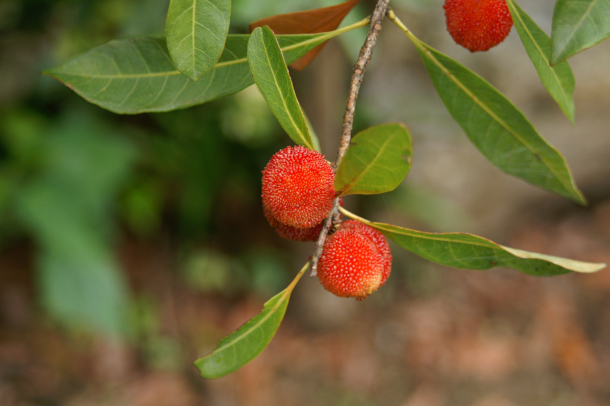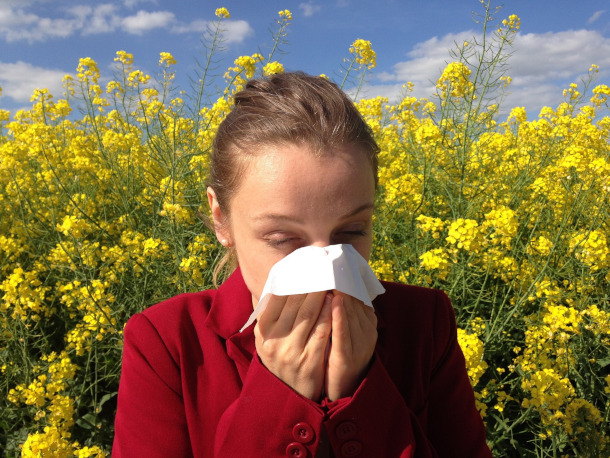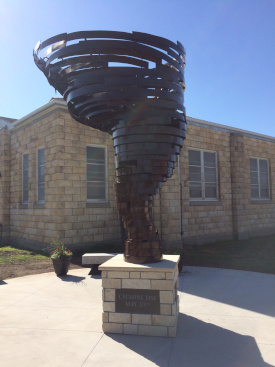Beyond the Headlines
Air Date: Week of May 19, 2023

The yangmei fruit is native to eastern Asia, but changing weather means more farmers are starting to grow the blight-resistant crop in California. (Photo: kanonn, Flickr, CC BY-ND 2.0)
This week, Living on Earth contributor Peter Dykstra joins Host Jenni Doering to share how exotic fruits could give California farmers options for replacing thirstier crops like almonds in a warming world. They also discuss how warmer temperatures mean more flowering days each year and therefore longer allergy seasons. In history they look back to the precise date, three years in a row, that the little town of Codell, Kansas was hit by tornadoes.
Transcript
CURWOOD: It’s Living on Earth, I’m Steve Curwood
DOERING: And I’m Jenni Doering.
And it's time now for a look beyond the headlines with Peter Dykstra, Living on Earth contributor, who joins us from Atlanta, Georgia. Hey, Peter, how you doing this week?
DYKSTRA: Doing well, the weather's turning warm, and we're going to talk about warm weather on the opposite side of North America. California, agricultural giant, is looking at a farming future where climate change may mandate that they're growing many completely different crops than anything we're accustomed to as coming from California to your grocery.
DOERING: Huh. I imagine more drought resistant crops, and heat resistant?
DYKSTRA: Yeah, drought resistant, heat resistant, and just requiring less water. When you look at some of the most financially rewarding crops to grow in California's Central Valley, you're talking in some cases about nuts. Almonds are particularly inefficient users of water, and therefore, they're going to be looked on more suspiciously as something that a farmer can make a go of. On the other hand, you've got fruit like yangmei from China. It's said to taste like a pomegranate... and pine resin?
DOERING: Interesting. Maybe our taste buds will get a little bit of adventure from this change?
DYKSTRA: Lucuma trees would be another one, coming from South America. They're said to look like avocados and taste like yams. Dragonfruit is one that I've actually seen in groceries here in the Atlanta area. And that could be another source of nutrition that could be more common, and therefore cheaper, for American consumers.
DOERING: Yum. All right, Peter, do you have anything tasty for us for the second story?
DYKSTRA: Nope. We're gonna move from the tastebuds up to the nose and sinuses. Because there's a report out from the nonprofit group Climate Central that has told us that between 1970 and the year 2021, allergy season, pollen season, has lengthened by about 15 days in just about all of the 200 cities that they studied throughout the United States.

Warming weather is lengthening the average allergy season in many places across the United States. (Photo: Cenczi, Pixabay, Pixabay Content License)
DOERING: Well, Peter, that's just an average, right? So, are some cities dealing with many more allergy days each year?
DYKSTRA: Some are worse. You know, the worst experience I ever had with some of my serious hay fever allergies was actually in the middle of the Nevada desert. It sounds like it's even worse now. The most absurd lengthening of allergy season in an American city, almost 100 days longer than it used to be, seems to have come in Reno, Nevada. All over the country, particularly in places that are already warm and wet, like here in Atlanta, you're going to see a longer pollen season as we're dealing with warmer and wetter weather.
DOERING: Oh no, not good news for allergy sufferers, I'm afraid. What do you have for us in the history books, Peter?

A sculpture in Codell, Kansas memorializes “Cyclone Day”. (Photo: Palbert01, Wikimedia Commons, CC BY-SA 4.0)
DYKSTRA: This one is really weird. We go to the heart of tornado alley, a little farming town called Codell, Kansas. Three years to the day in a row: May 20, 1916, May 20, 1917, May 20, 1918. What are the odds of the same little town being smacked by a tornado for three years in a row? The final of those three years, May 20, 1918, an estimated F4 tornado went through the middle of Codell. But get this, a lot of the speculation at the time is that superstition saved lives. So many people were afraid that there would be a tornado on May 20 in 1918 - and there was - that people were more careful. They either stayed inside or got out of town completely. And a year later after that, there was no four-in-a-row streak for little Codell, Kansas.
DOERING: Peter Dykstra is a Living on Earth contributor, and we'll talk to you again next time, Peter.
DYKSTRA: Alright, Jenni. Thanks a lot and talk to you soon.
DOERING: And there's more on these stories on the Living on Earth website. That's LOE.org.
Links
Axios | “Here’s Where Allergy Season Is Getting Longer.”
Read more on the three-year tornado streak in Codell, Kansas
Living on Earth wants to hear from you!
Living on Earth
62 Calef Highway, Suite 212
Lee, NH 03861
Telephone: 617-287-4121
E-mail: comments@loe.org
Newsletter [Click here]
Donate to Living on Earth!
Living on Earth is an independent media program and relies entirely on contributions from listeners and institutions supporting public service. Please donate now to preserve an independent environmental voice.
NewsletterLiving on Earth offers a weekly delivery of the show's rundown to your mailbox. Sign up for our newsletter today!
 Sailors For The Sea: Be the change you want to sea.
Sailors For The Sea: Be the change you want to sea.
 The Grantham Foundation for the Protection of the Environment: Committed to protecting and improving the health of the global environment.
The Grantham Foundation for the Protection of the Environment: Committed to protecting and improving the health of the global environment.
 Contribute to Living on Earth and receive, as our gift to you, an archival print of one of Mark Seth Lender's extraordinary wildlife photographs. Follow the link to see Mark's current collection of photographs.
Contribute to Living on Earth and receive, as our gift to you, an archival print of one of Mark Seth Lender's extraordinary wildlife photographs. Follow the link to see Mark's current collection of photographs.
 Buy a signed copy of Mark Seth Lender's book Smeagull the Seagull & support Living on Earth
Buy a signed copy of Mark Seth Lender's book Smeagull the Seagull & support Living on Earth

